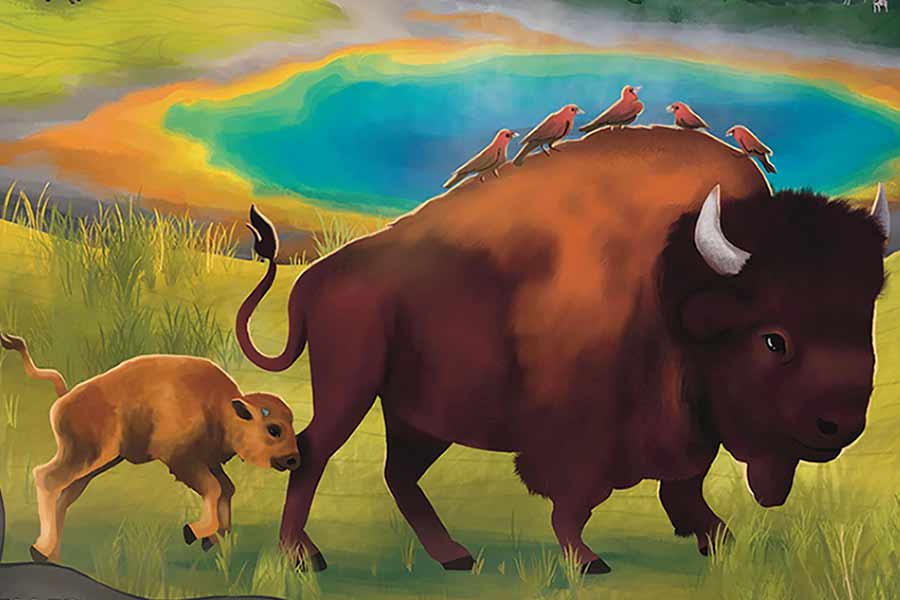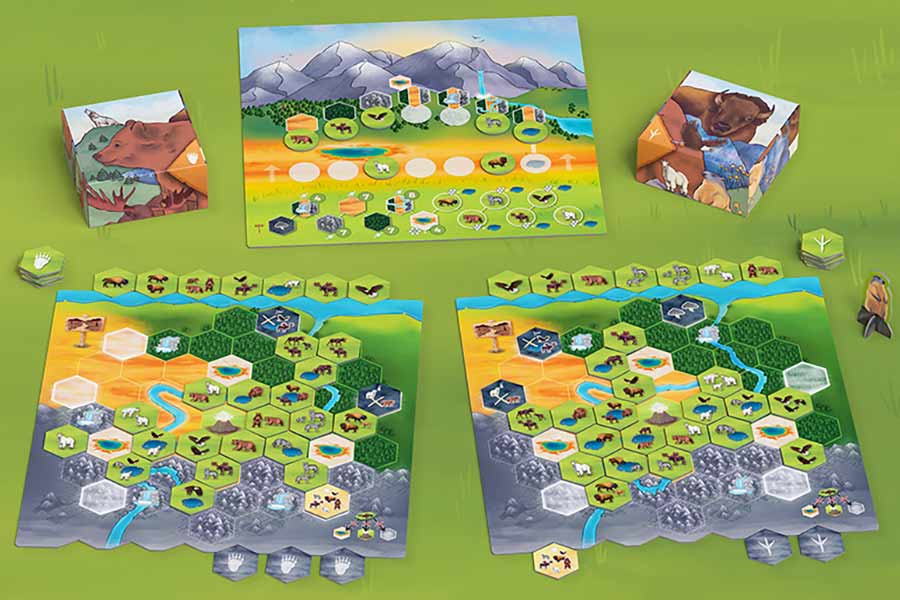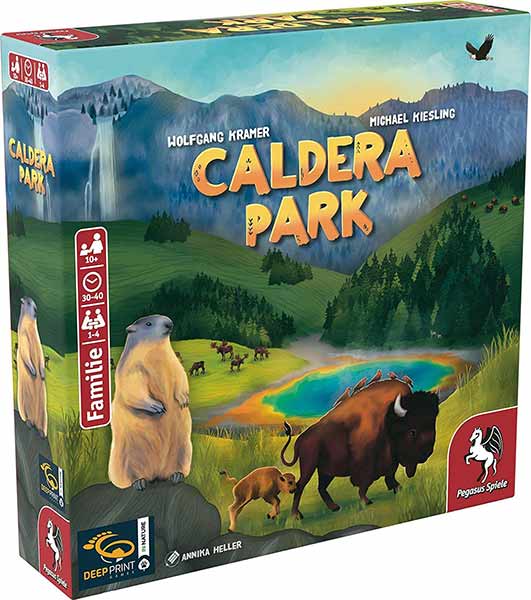When I first held Caldera Park in my hands, I asked myself: What is a caldera? in the predecessor Savannah Park The reference was obvious to me, but here I had to consult Wikipedia first. Caldera is the Spanish name for a basin of volcanic origin. A well-known example is the Ngorongoro crater in Tanzania, where famous zoologist and wildlife filmmaker Bernard Grzemek is buried (older than us remember). But there are also some Calderas in North America and this is exactly where the board game by Wolfgang Kramer and Michael Kiesling (Deep Print Games) is located.
What is Caldera Park?
The objective of Caldera Park is to group six species of animals into as large groups as possible on the game board, which represents the caldera as 52 hexagonal fields. The front of the painting shows different landscapes (forest, prairie, mountains) and locations on them (volcano, geysers, waterfalls, river). Six special squares evenly spaced around the edge of the board. These are the weather fields that will cause some nasty surprises in the course of the game. But one after another.
Caldera Park and materials
When the game chest is opened, four small chests appear. Each one contains 35 animal tiles and 10 weather tiles for up to four players. They only differ in the hindquarters through the footprints of the marmot, elk, bear and eagle. Animal species (wolf, mountain goat, bison, elk, eagle, and bear) are printed with different numbers and combinations on the front of the animal tiles. Some tiles also have water spots, which play an important role in scoring.
Uncontrollable things from weather tiles
Each player shuffles their animal tiles, places them face down and places seven of them in the appropriately shaped width at the top of the game board. The same thing happens with weather tiles, but only six out of ten tiles are used. The only positive tile – the sun – is always in play and is also the only one open. Five more are randomly selected and placed face down on the bottom of the game board along with the open sun. The rest is up to the invisible square, so you never know what weather disasters you’ll have to deal with in the game. A weather tile is placed on one of the six spaces before the game starts, then at the start of the first round, you place another one on the next clockwise space.
One goes ahead and identifies the type of animal
Now it’s each player’s turn to lay out the 7 animal tiles from the screen. The currently active player always selects on a separate board what types of animals to place on which terrain, for example bison in the mountains. Every player must follow this rule. If there is no bison in your screen, you can choose a piece. If the selected terrain is already fully occupied, you can also choose one freely here. This is a rule that you can also use very tactically to position your animals profitably.
There is a special rule for placing water points. It may always be placed on any terrain. The special thing about water wells is that they act as a multiplier for all the animals that appear on them and in their vicinity. No matter how large the animal family is at the end of the game, it scores zero points without a watering hole.
Record with groundhogs in Caldera Park
After all seven tiles are placed, a new round begins and another weather tile is placed on the playing field. When all the tiles have been placed at the end of five rounds, the final score takes place. The badger character walks through the individual classification categories, which are then noted on the attached board.
First, we look at how weather tiles are literally destroying our rating. Some atmospheric phenomena, such as a hurricane, force us to overturn some species of nearby animals or water wells, removing them from the score. During a thunderstorm, the turn depends on how many animals are on adjacent tiles. Annoying when you’re at the mercy of fickle weather, important animals, or worse – water holes – getting lost.
Once the weather is checked, the recording continues. Fully covered landscape types score seven points each, and fully covered river up to eight. In the case of geysers, they must be completely reconstructed in order to score four points each, and then the largest families of animals of each type are scored. The weather tile with the sun increases each neighboring family by one copy. The player with the most points wins.
Caldera park and fun to play
Caldera Park has simple rules and is therefore easy to play for 30 to 40 minutes. Complexity comes into play through the unpredictability of weather tiles. In the beginning, you can think about where to start the position and where to avoid conflict with neighboring animal tiles. But starting with the third tile at the latest and gaining a fuller and fuller slate, you pray that groups of animals that have already been laid will not suddenly lose their watering holes to a hailstorm or heavy rain. The swearing at the table is great when the animal family, so painstakingly made up, is torn apart by another climatic phenomenon once again.
What can still be reasonably planned on the front of the plan becomes a real gamble on the back of ‘Geysirpark storm warning’. On the other hand, there are two more weather tiles to place and they are also distributed on the board so that you cannot escape their negative influence. To compensate, though, you can always choose between two weather tiles facing up from the screen. However, the choice is often between plague and cholera. Successful solo challenge comes out of the game variables.
Attractive rules, random factor, frustration tolerance
Due to the attractiveness and well-structured rules, the game is explained quickly and is therefore ideal for families. However, there must be a certain tolerance of frustration, because weather phenomena strike mercilessly and are of course subject to a certain factor of luck due to hidden clouds.
Due to the structure of the game board in the standard variant, it is quite possible to cover the entire connected landscape, but not all at the same time. Here you have to think about what evaluation goals you want to achieve in the end. However, in the at-the-back variant, the landscape types are not continuous, making it difficult to cover them all. So there is variety and I always enjoy trying (solo too) to get more points out of the game.
Evaluation with the application is possible
The plan’s graphics are more colorful than those of its predecessor, Savannah Park, but I personally don’t like it very much. In addition, the animals on the tiles are very small and therefore difficult to distinguish, also in terms of coloring bison, elk and bear.
For people like me who don’t want to add the points on the scoreboard manually, the publisher Deep Print Games has created an app where the score sheets of all the publisher’s games are provided digitally and the adding is done there. You can even save hands and look at your game history afterwards.
around Caldera Park
- Address: Caldera Park
- Publisher: Deep Print Games
- Author: Wolfgang Kramer, Michael Kiesling
- Number of players (from to): 1-4
- Age (from or to in years): 10
- Duration in minutes: 30-40
- Atiq: 2022
- video:

“Explorer. Communicator. Music geek. Web buff. Social media nerd. Food fanatic.”











More Stories
A fossilized creature may explain a puzzling drawing on a rock wall.
MrBeast Sued Over ‘Unsafe Environment’ on Upcoming Amazon Reality Show | US TV
Watch comets Lemmon and SWAN approach Earth today